
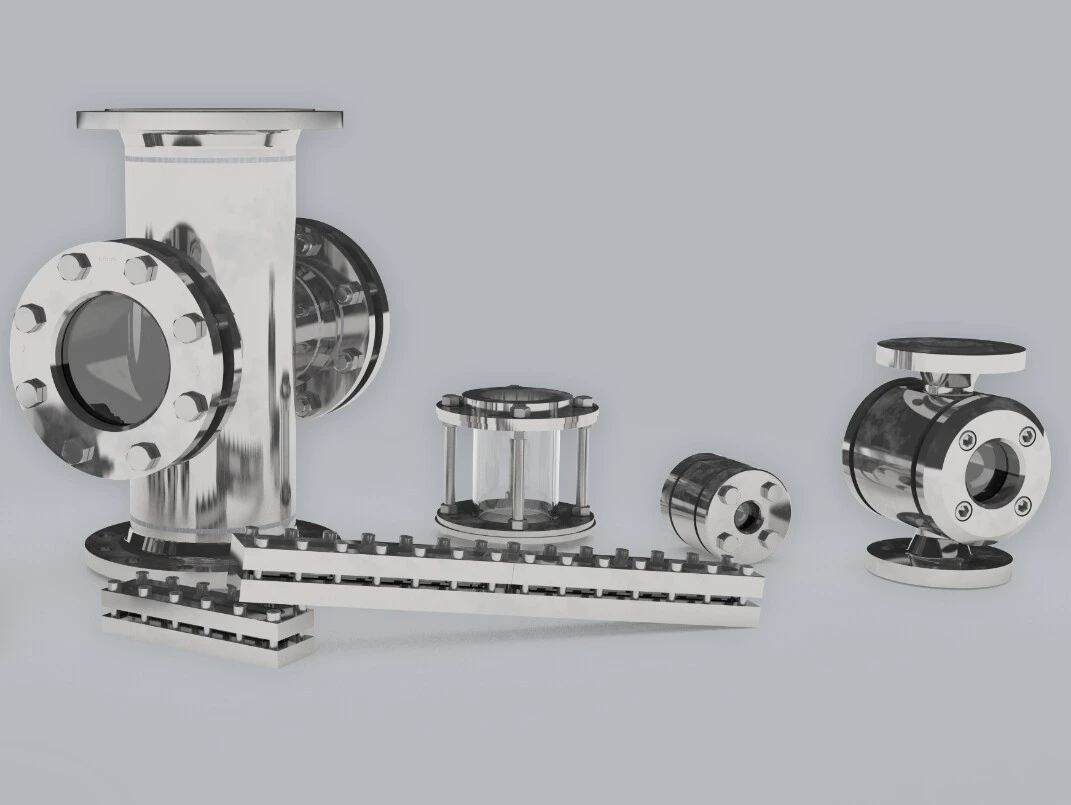
Requirements for Sight Glass Fittings
Due to new regulations, adjustments in laws, or customer requests, the requirements for the valve industry are continuously rising. This applies to all types of sight glass fittings - from flow sight glasses to level indicators to container and tubular sight glasses.
This report provides insight into the selection criteria for sight glass components, their gasket technology, and two examples of sight glass fittings for special application areas.
The industrial and regulatory requirements for plant builders and operators are continuously increasing. The impact of these regulatory adjustments and requirements is also being felt in the valve industry. For example, innovations in the TA-Luft affect flange connections, sealing technology, and even sight glass fittings. In principle, the requirements are covered by good standardization, such as container sight glasses according to DIN 28120 (ACI Type 320), DIN 28121 (ACI Type 321), or flow sight glasses according to DIN 3237 (ACI Type 550). But what if the requirements of the plant builders or operators for efficient and, above all, safe monitoring of the process exceed the capabilities of standardized sight glasses?
In principle, a wide range of options for process monitoring is offered. Whether it be container sight glasses (e.g., ACI Type 320 or 321), flow sight glasses (e.g., ACI Type 550 or 530), level indicators (e.g., ACI Type 330 or 410) or tubular sight glasses (e.g., ACI Type 620 or 622) - for flange mounting, screw-on, or even for welding. These standard sight glasses occasionally reach their limits. Especially in the high-pressure and high-temperature range, but particularly when combining high pressure and high temperature, one cannot always rely on a standard. It becomes particularly problematic when a valve is used for a very aggressive, explosive, or highly dangerous medium. By using high-quality materials, we ensure that the requirements for the sight glass fitting are met and fulfilled, even with special sight glass fittings. When manufacturing very versatile valves, it is important to have a broad selection of components and materials available. Important components include, for example, glass, gaskets, and screws. To cover a wide media compatibility, the chemical composition of the materials used is also crucial. For example, stainless steel doesn't equate to stainless steel, and not every material is universally media-resistant. However, materials are by no means everything. The necessary expertise to manufacture such special valves in compliance with regulations must be present, along with a good quality management system and extensive testing. Most pressure-holding equipment parts, such as flow sight glasses (e.g., ACI Type 550 or 530), must be designed and extensively tested in compliance with the pressure equipment directive 2014/68/EU in connection with the AD2000 and the corresponding harmonized standards for quality and conformity.
We would like to illustrate that there are possibilities, especially for more complex applications, using the following examples.
Application Example: Medium
A large chemical company required a 3-way flow sight glass for process monitoring. The requirements were clearly defined:
- Medium: Phosgene gas
- Temperature range (TSmin /max): -20 °C / +280 °C
- Working pressure: (PSmax): 40 bar
- Nominal size: DN150
The customer’s main focus was on ensuring the highest possible safety within the application range of 40 bar and the temperature of 280 °C. For this, only our ACI Type 590, 3-way flow sight glass with two viewports, was suitable.
For the housing, we used an advanced version of our ACI Type 590 high-pressure housing DN150 PN250, which was adapted for three V-flanges DN150 PN63 according to DIN 1092-1 Type 11. In this design, the mentioned connection V-flanges are the weakest pressure-bearing components of the sight glass housing. It was important to use the flanges in PN63 to achieve the full 40 bar at a temperature of 280 °C. These are permissible and designed for 43.5 bar according to the pressure-temperature rating of DIN EN 1092-1. For quick and independent determination of permissible pressures regarding temperature, pressure class (PN / Class), and material, you can find our free pressure-temperature rating according to DIN EN 1092-1 and ASME B16.5 under the "Tools" category on our website.
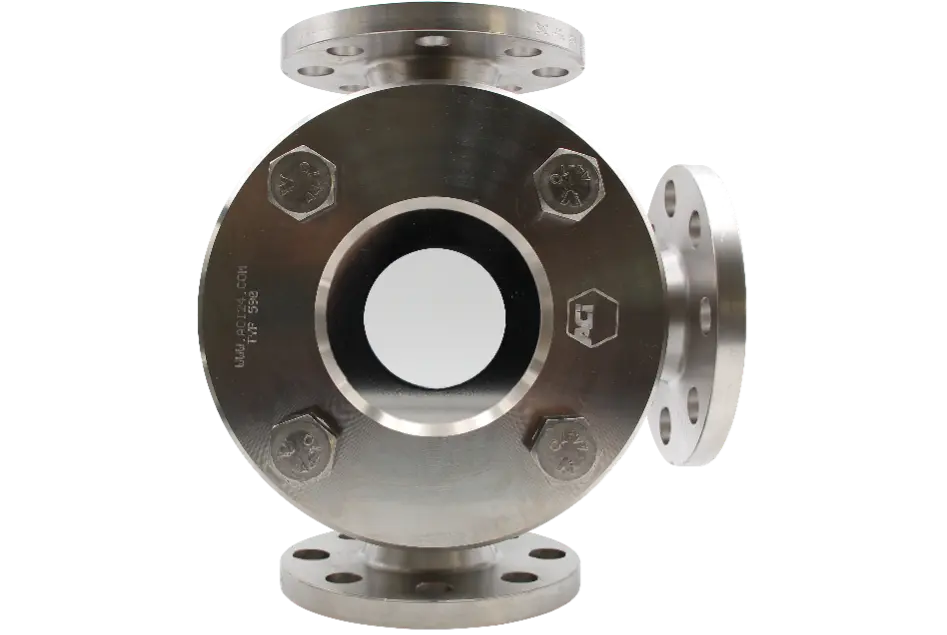
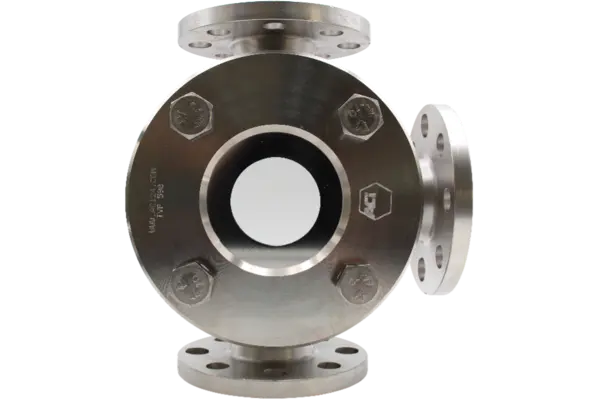
For the housing and flange material, we decided on stainless austenitic steel 1.4539 (X1NiCrMoCu25-20-5 / 904L) because of its particularly favorable properties regarding the medium. The welding process was carried out by qualified and certified personnel. For stainless austenitic steels, subsequent pickling and passivation of the weld seams is mandatory to maintain corrosion resistance. To meet our customer's safety requirements, all weld seams underwent a 100% inspection using X-ray imaging, and the completely assembled sight glass was subjected to a TÜV approval with a 3.2 certificate. Unless otherwise specified, the scope of documentation is generally based on the applicable regulations of the AD2000 and the pressure equipment directive. We replaced our standard sight glasses made of Borosilicate glass with metal-fused Borosilicate sight glasses.
Only in this way were we able to apply an even more uniform and higher surface pressure for an effective sealing connection against phosgene gas between the glass and the housing, in addition to the extended bolt circle.
Novaphit® VS was chosen as the sealing material, which is a graphite gasket made from a pre-compressed graphite foil of high purity expanded graphite (purity > 99%). Due to the temperature range of the application (-20 °C to +280 °C), the possibility of condensate formation as well as the formation of hydrochloric acid cannot be excluded. For this reason, the stainless steel reinforcing insert made of 1.4404, which is otherwise standard in novaphit® gaskets, was omitted.
Application Example: Pressure
Regarding several high-pressure Flow sight glasses with female thread for a high-pressure oil application, we were contacted by a large aircraft and helicopter manufacturer.
The requirements were:
- Medium: Oil
- Temperature range (TSmin /max): -10 °C to +90 °C
- Working pressure: (PSmax): 400 bar
- Connection nominal size: G1/2“
We were able to rely on one of our standard products for this application case, the ACI Type 522, high-pressure Flow sight glass with female thread.
The ACI Type 522 was designed in the 400-bar variant for a maximum temperature of 280 °C, thus easily meeting the customer's requirements. Therefore, we were able to deliver the high-pressure Flow sight glasses per the customer's wishes and specifications without a long wait. For these sight glass fittings, high-quality Borosilicate glass specially manufactured for ACI was used. Special glasses, which are not listed in the corresponding standard due to their high requirements, are fundamentally designed and calculated by us in accordance with that standard for the required application area. For the design of such glasses, our free glass advisor for a variety of glass materials and shapes is also available on our website in the "Tools" category.
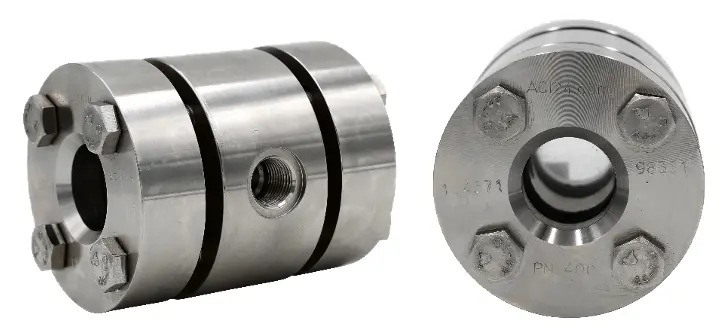
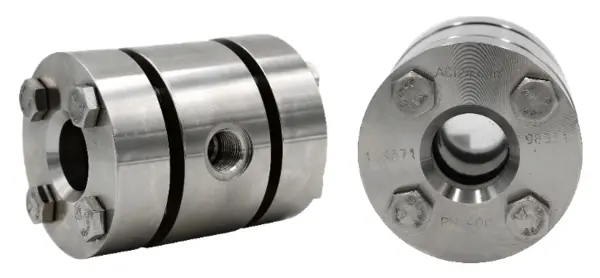
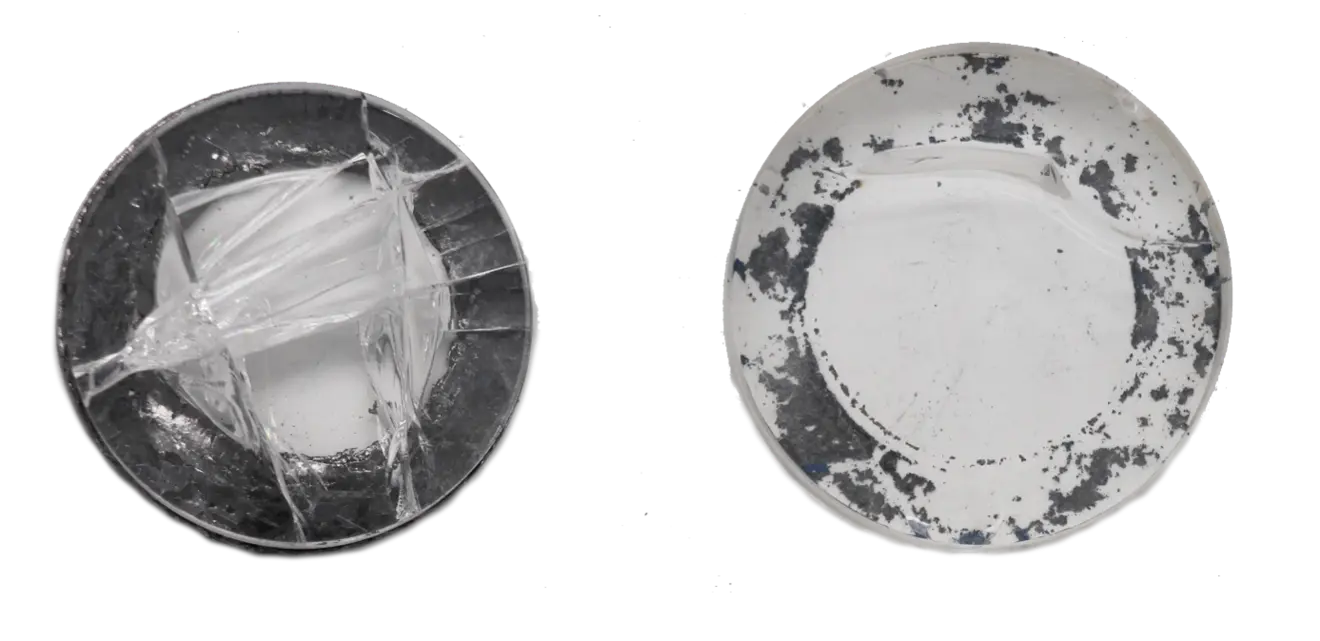
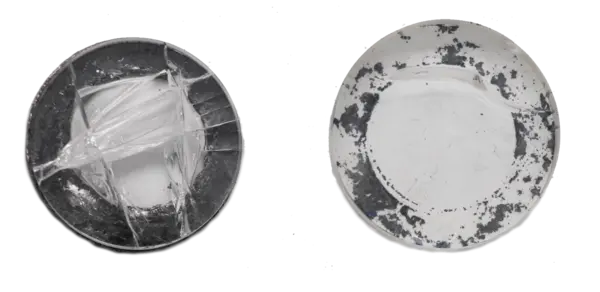
For the housing material, a 1.4571 (X6CrNiMoTi17-12-2 / A316Ti) stainless steel made in Germany was used, which has the best properties for high-pressure applications and is characterized by its durability and corrosion resistance. For this reason, it does not require an additional protective paint layer. Regarding the gasket, we opted for the novaphit® MST with standard XP technology. This has shown the best results in our sight glass fittings in the past due to its very high-quality properties. The following image shows damaged sight glass plates that were installed with a commercially available graphite gasket.
In addition, the so-called XP technology is used as standard, which represents an inorganic deep passivation of the graphite. The resulting effect concerns two important areas. On the one hand, the oxidation stability of the graphite is increased, so that significantly better long-term properties can be achieved, especially in applications with higher temperatures (> 300 °C). On the other hand, the tendency of the graphite to adhere at the sealing surface is drastically reduced or even completely avoided.
The residues of the novaphit® MST with XP technology (image on the right) can be easily removed completely with a damp cleaning cloth.
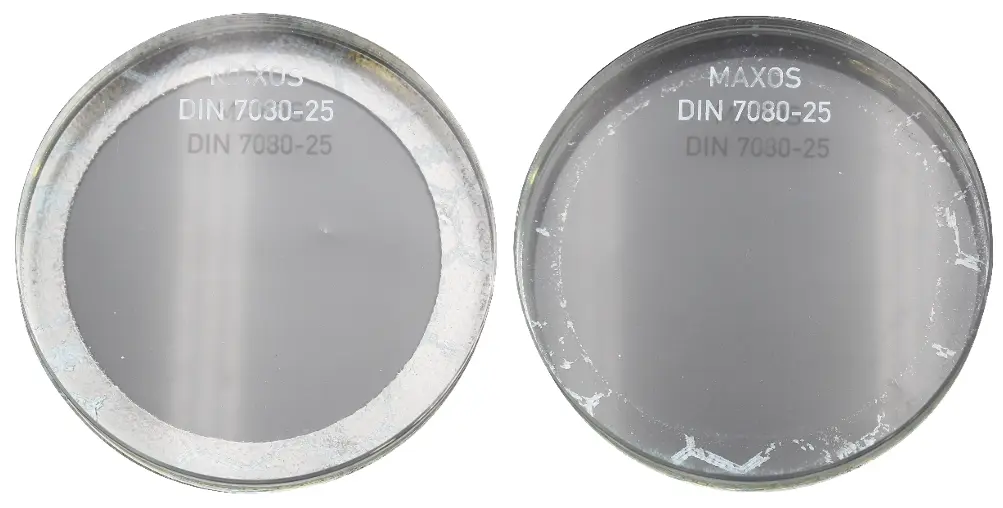
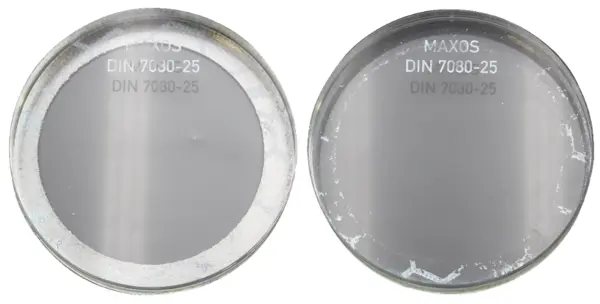
Application Example: Low Temperature and High Pressure
We received an inquiry from a petroleum refinery customer in Norway for a high-pressure sight glass for low temperatures, which had to be seaworthy. The following requirements were to be met:
- Medium: CO2, oil, methane gas, and seawater
- Temperature range (TSmin/max.): -60 °C / +150 °C
- Class / PN (PSmax): Class 900 / 150 bar (125 bar)
- Nominal size: 3“ (DN80)
Our customer was particularly concerned about seawater protection and low temperature resistance at -60°C. For this purpose, we could rely on our ACI Type 520A, a high-pressure flow sight glass with ANSI flanges.
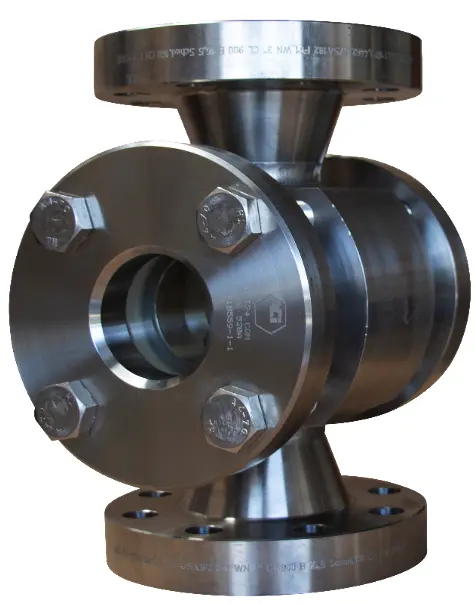
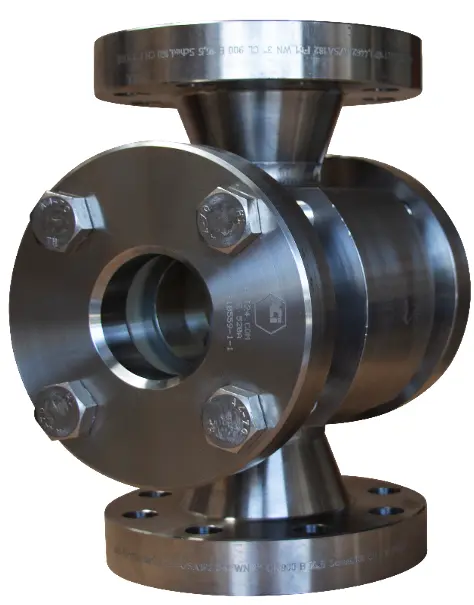
As a material for the housing of the Type 520A high-pressure flow sight glass, we used stainless steel 1.4462. This material is seawater resistant due to its outstanding properties and is also very resistant to CO2, oil, and methane gas. The connection flanges according to ASME 16.5 B RF in 3" Class 900 were also made from this material. For this material, we required a 3.2 certificate with proof of suitability. Furthermore, we classified the sight glass according to AD2000 leaflet W10 (Materials for low temperatures) from load group I to load group II. By this step, the chosen material (1.4462) was able to achieve the required -60 °C instead of the approved -40 °C. The welding process of the main housing required a 100% X-ray inspection of the two weld seams due to this reclassification.
We manufactured the glass from specially made Borosilicate glass similar to DIN 7080. This glass is standardly resistant to the media mentioned above and suitable for seawater. As the sealing material, we used the novaphit® MST graphite gasket, as it is perfectly suitable for high-pressure applications in the low-temperature range due to its special structural design.
We successfully conducted a pressure test with water at room temperature for 60 seconds at PN 150 bar × 1.5 (225 bar) on our own pressure testing rig.
A project in mind?
We can help you!
Please feel free to contact us and we will discuss together how we can assist you!